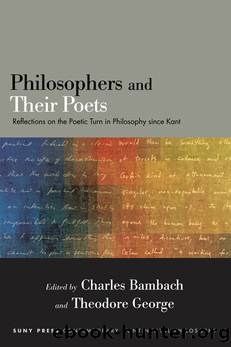Philosophers and Their Poets by Charles Bambach;Theodore George;

Author:Charles Bambach;Theodore George;
Language: eng
Format: epub
Publisher: State University of New York Press
Published: 2019-07-14T16:00:00+00:00
Notes
1. Gregory, 252.
2. Nietzsche, Gay Science, 84.
3. Seth Benardete and Gregory Nagy both observe that even though heroes were mortal, they were above ordinary caliber. See “Achilles and the Iliad,” in Benardete (15–33, here 18); Nagy (9–10).
4. Despite the revisions that the notion of courage underwent, the requirement of extraordinariness has been preserved. It is there in Plato and Aristotle, and continues to inform most contemporary views. We call courageous those who go the extra mile, and we are especially moved by the death of those who left behind too great a life, or who departed too early, for their beliefs.
5. Heretofore abbreviated as BT.
6. Nagy, 32.
7. Ibid., 21.
8. Nagy remarks that Hector elicited the sympathy of the ancient Greeks as well, but not to the extent that he does from the moderns (21). Modernity vilifies Achilles, whom it does not understand. Hector becomes the proper object of modern pity because of his defeat. This shift of allegiance signals the passage from an aestheticized version of ethics to a “pure” morality.
9. Benardete, 258. See “Plato’s Laches: A Question of Definition” in Benardete (257–76). For Benardete, Nicias and Laches represent the divine and beastly view of courage, respectively. The former is the fully epistemic notion of courage as knowledge and foreknowledge of hope and fear; the latter comes closer to Homeric, natural power. The human forms the middle point between god and beast, and thus, to tailor courage to this middle point, Socrates foregoes the nobility (and aestheticism) afforded by the Homeric model. To recall Nagy and the Achillean example, the Homeric hero is not commensurate to ordinary humans: Achilles oscillates between the nearly divine (he is half-divine on his mother’s side) and the beastly (his treatment of Hector).
10. Benardete, 261.
11. Aristotle, Nicomachean Ethics 1115a15–20, 1116b4–5.
12. Explaining the various semantic interrelations between the good, the noble, and the beautiful (kalos/kallos), translator C. D. C. Reeve of The Nicomachean Ethics observes that what makes acts ethically choiceworthy and praiseworthy is that they lie in the mean (meson), thus exhibiting a sense of order and proportionality, which are aesthetic qualities. Reeve concludes: “This brings us full circle, connecting what is ethically kalon to what is aesthetically noble, lending the former too an aesthetic tinge” (204n20).
13. Aristotle, Nicomachean Ethics, 1115a30–31, 1115b21–22.
14. Ibid., 1115a25.
15. Nietzsche opposes the Romantic reading of Homer as a naive artist: “Where we encounter the ‘naïve’ in art, we should recognize the highest effect of Apollinian culture—which always must first overcome an empire of Titans and slay monsters” (43). He also describes the severity of Doric art in terms of a “permanent military encampment of the Apollinian” (47).
16. Summarily, Luyster argues that BT was written in response to Schopenhauer’s pessimism. Nietzsche’s own ambivalent relation to this philosophy—he was drawn to it but also wished to affirm life—led him to the Apollonian/Dionysian divide. Tragedy as a reconciliation of the two opposites is, for Luyster, only a Hegelian incidental. On the primary opposition, Luyster writes: “As we consider . . . the implications
Download
This site does not store any files on its server. We only index and link to content provided by other sites. Please contact the content providers to delete copyright contents if any and email us, we'll remove relevant links or contents immediately.
The remains of the day by Kazuo Ishiguro(8814)
Tools of Titans by Timothy Ferriss(8211)
Giovanni's Room by James Baldwin(7188)
The Black Swan by Nassim Nicholas Taleb(7009)
Inner Engineering: A Yogi's Guide to Joy by Sadhguru(6722)
The Way of Zen by Alan W. Watts(6502)
Asking the Right Questions: A Guide to Critical Thinking by M. Neil Browne & Stuart M. Keeley(5627)
The Power of Now: A Guide to Spiritual Enlightenment by Eckhart Tolle(5603)
The Six Wives Of Henry VIII (WOMEN IN HISTORY) by Fraser Antonia(5394)
Astrophysics for People in a Hurry by Neil DeGrasse Tyson(5130)
Housekeeping by Marilynne Robinson(4328)
12 Rules for Life by Jordan B. Peterson(4249)
Double Down (Diary of a Wimpy Kid Book 11) by Jeff Kinney(4204)
The Ethical Slut by Janet W. Hardy(4172)
Skin in the Game by Nassim Nicholas Taleb(4161)
Ikigai by Héctor García & Francesc Miralles(4123)
The Art of Happiness by The Dalai Lama(4063)
Skin in the Game: Hidden Asymmetries in Daily Life by Nassim Nicholas Taleb(3929)
Walking by Henry David Thoreau(3892)
